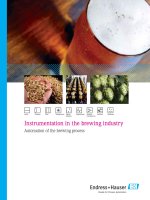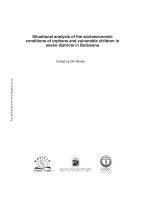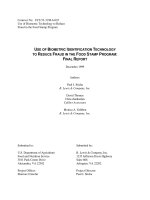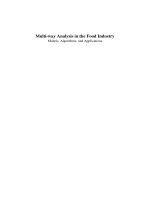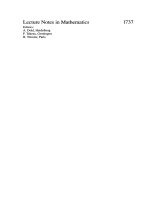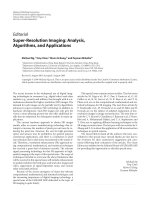Multi-way Analysis in the Food Industry Models, Algorithms, and Applications pptx
Bạn đang xem bản rút gọn của tài liệu. Xem và tải ngay bản đầy đủ của tài liệu tại đây (2.31 MB, 311 trang )
Multi-way Analysis in the Food Industry
Models, Algorithms, and Applications
This monograph was originally written as a Ph. D. thesis (see end of file for
original Dutch information printed in the thesis at this page)
i
MULTI-WAY ANALYSIS IN THE FOOD INDUSTRY
Models, Algorithms & Applications
Rasmus Bro
Chemometrics Group, Food Technology
Department of Dairy and Food Science
Royal Veterinary and Agricultural University
Denmark
Abstract
This thesis describes some of the recent developments in multi-way
analysis in the field of chemometrics. Originally, the primary purpose of this
work was to test the adequacy of multi-way models in areas related to the
food industry. However, during the course of this work, it became obvious
that basic research is still called for. Hence, a fair part of the thesis
describes methodological developments related to multi-way analysis.
A multi-way calibration model inspired by partial least squares regres-
sion is described and applied (N-PLS). Different methods for speeding up
algorithms for constrained and unconstrained multi-way models are
developed (compression, fast non-negativity constrained least squares
regression). Several new constrained least squares regression methods of
practical importance are developed (unimodality constrained regression,
smoothness constrained regression, the concept of approximate constrai-
ned regression). Several models developed in psychometrics that have
never been applied to real-world problems are shown to be suitable in
different chemical settings. The PARAFAC2 model is suitable for modeling
data with factors that shift. This is relevant, for example, for handling
retention time shifts in chromatography. The PARATUCK2 model is shown
to be a suitable model for many types of data subject to rank-deficiency. A
multiplicative model for experimentally designed data is presented which
extends the work of Mandel, Gollob, and Hegemann for two-factor
experiments to an arbitrary number of factors. A matrix product is introdu-
ced which for instance makes it possible to express higher-order PARAFAC
models using matrix notation.
Implementations of most algorithms discussed are available in
MATLAB
TM
code at . To further facilitate the
ii
understanding of multi-way analysis, this thesis has been written as a sort
of tutorial attempting to cover many aspects of multi-way analysis.
The most important aspect of this thesis is not so much the mathemati-
cal developments. Rather, the many successful applications in diverse
types of problems provide strong evidence of the advantages of multi-way
analysis. For instance, the examples of enzymatic activity data and sensory
data amply show that multi-way analysis is not solely applicable in spectral
analysis – a fact that is still new in chemometrics. In fact, to some degree
this thesis shows that the noisier the data, the more will be gained by using
a multi-way model as opposed to a traditional two-way multivariate model.
With respect to spectral analysis, the application of constrained PARAFAC
to fluorescence data obtained directly from sugar manufacturing process
samples shows that the uniqueness underlying PARAFAC is not merely
useful in simple laboratory-made samples. It can also be used in quite
complex situations pertaining to, for instance, process samples.
iii
A
CKNOWLEDGMENTS
Most importantly I am grateful to Professor Lars Munck (Royal Veterinary
and Agricultural University, Denmark). His enthusiasm and general
knowledge is overwhelming and the extent to which he inspires everyone
in his vicinity is simply amazing. Without Lars Munck none of my work
would have been possible. His many years of industrial and scientific work
combined with his critical view of science provides a stimulating environ-
ment for the interdisciplinary work in the Chemometrics Group. Specifically
he has shown to me the importance of narrowing the gap between
technology/industry on one side and science on the other. While industry
is typically looking for solutions to real and complicated problems, science
is often more interested in generalizing idealized problems of little practical
use. Chemometrics and exploratory analysis enables a fruitful exchange of
problems, solutions and suggestions between the two different areas.
Secondly, I am most indebted to Professor Age Smilde (University of
Amsterdam, The Netherlands) for the kindness and wit he has offered
during the past years. Without knowing me he agreed that I could work at
his laboratory for two months in 1995. This stay formed the basis for most
of my insight into multi-way analysis, and as such he is the reason for this
thesis. Many e-mails, meetings, beers, and letters from and with Age
Smilde have enabled me to grasp, refine and develop my ideas and those
of others. While Lars Munck has provided me with an understanding of the
phenomenological problems in science and industry and the importance of
exploratory analysis, Age Smilde has provided me with the tools that enable
me to deal with these problems.
Many other people have contributed significantly to the work presented
in this thesis. It is difficult to rank such help, so I have chosen to present
these people alphabetically.
Claus Andersson (Royal Veterinary and Agricultural University,
Denmark), Sijmen de Jong (Unilever, The Netherlands), Paul Geladi
(University of Umeå, Sweden), Richard Harshman (University of Western
Ontario, Canada), Peter Henriksen (Royal Veterinary and Agricultural
University, Denmark), John Jensen (Danisco Sugar Development Center,
Denmark), Henk Kiers (University of Groningen, The Netherlands), Ad
iv
Louwerse (University of Amsterdam, The Netherlands), Harald Martens
(The Technical University, Denmark), Magni Martens (Royal Veterinary and
Agricultural University, Denmark), Lars Nørgaard (Royal Veterinary and
Agricultural University, Denmark), and Nikos Sidiropoulos (University of
Virginia) have all been essential for my work during the past years, helping
with practical, scientific, technological, and other matters, and making life
easier for me.
I thank Professor Lars Munck (Royal Veterinary & Agricultural Universi-
ty, Denmark) for financial support through the Nordic Industrial Foundation
Project P93149 and the FØTEK fund.
I thank Claus Andersson, Per Hansen, Hanne Heimdal, Henk Kiers,
Magni Martens, Lars Nørgaard, Carsten Ridder, and Age Smilde for data
and programs that have been used in this thesis. Finally I sincerely thank
Anja Olsen for making the cover of the thesis.
v
T
ABLE OF CONTENTS
Abstract i
Acknowledgments iii
Table of contents v
List of figures xi
List of boxes xiii
Abbreviations xiv
Glossary xv
Mathematical operators and notation xviii
1.
BACKGROUND
1.1 INTRODUCTION
1
1.2 MULTI-WAY ANALYSIS
1
1.3 HOW TO READ THIS THESIS
4
2.
MULTI-WAY
DATA
2.1 INTRODUCTION
7
2.2 UNFOLDING
10
2.3 RANK OF MULTI-WAY ARRAYS
12
3.
MULTI-WAY
MODELS
3.1 INTRODUCTION
15
Structure 17
Constraints 18
Uniqueness 18
Sequential and non-sequential models 19
3.2 THE KHATRI-RAO PRODUCT
20
vi
Parallel proportional profiles 20
The Khatri-Rao product 21
3.3 PARAFAC
23
Structural model 23
Uniqueness 25
Related methods 28
3.4 PARAFAC2
33
Structural model 34
Uniqueness 37
3.5 PARATUCK2
37
Structural model 38
Uniqueness 39
Restricted PARATUCK2 40
3.6 TUCKER MODELS
44
Structural model of Tucker3 45
Uniqueness 48
Tucker1 and Tucker2 models 49
Restricted Tucker3 models 50
3.7 MULTILINEAR PARTIAL LEAST SQUARES REGRESSION
51
Structural model 52
Notation for N-PLS models 53
Uniqueness 53
3.8 SUMMARY
54
4.
ALGORITHMS
4.1 INTRODUCTION
57
4.2 ALTERNATING LEAST SQUARES
57
4.3 PARAFAC
61
Initializing PARAFAC 62
Using the PARAFAC model on new data 64
Extending the PARAFAC model to higher orders 64
4.4 PARAFAC2
65
Initializing PARAFAC2 67
Using the PARAFAC2 model on new data 67
Extending the PARAFAC2 model to higher orders 68
vii
4.5 PARATUCK2
68
Initializing PARATUCK2 71
Using the PARATUCK2 model on new data 71
Extending the PARATUCK2 model to higher orders 71
4.6 TUCKER MODELS
72
Initializing Tucker3 76
Using the Tucker model on new data 78
Extending the Tucker models to higher orders 78
4.7 MULTILINEAR PARTIAL LEAST SQUARES REGRESSION
78
Alternative N-PLS algorithms 83
Using the N-PLS model on new data 84
Extending the PLS model to higher orders 85
4.8 IMPROVING ALTERNATING LEAST SQUARES ALGORITHMS
86
Regularization 87
Compression 88
Line search, extrapolation and relaxation 95
Non-ALS based algorithms 96
4.9 SUMMARY
97
5.
VALIDATION
5.1 WHAT IS VALIDATION
99
5.2 PREPROCESSING
101
Centering 102
Scaling 104
Centering data with missing values 106
5.3 WHICH MODEL TO USE
107
Model hierarchy 108
Tucker3 core analysis 110
5.4 NUMBER OF COMPONENTS
110
Rank analysis 111
Split-half analysis 111
Residual analysis 113
Cross-validation 113
Core consistency diagnostic 113
5.5 CHECKING CONVERGENCE
121
5.6 DEGENERACY
122
viii
5.7 ASSESSING UNIQUENESS
124
5.8 INFLUENCE & RESIDUAL ANALYSIS
126
Residuals 127
Model parameters 127
5.9 ASSESSING ROBUSTNESS
128
5.10 FREQUENT PROBLEMS AND QUESTIONS
129
5.11 SUMMARY
132
6.
CONSTRAINTS
6.1 INTRODUCTION
135
Definition of constraints 139
Extent of constraints 140
Uniqueness from constraints 140
6.2 CONSTRAINTS
141
Fixed parameters 142
Targets 143
Selectivity 143
Weighted loss function 145
Missing data 146
Non-negativity 148
Inequality 149
Equality 150
Linear constraint 150
Symmetry 151
Monotonicity 151
Unimodality 151
Smoothness 152
Orthogonality 154
Functional constraints 156
Qualitative data 156
6.3 ALTERNATING LEAST SQUARES REVISITED
158
Global formulation 158
Row-wise formulation 159
Column-wise formulation 160
6.4 ALGORITHMS
166
ix
Fixed parameter constrained regression 167
Non-negativity constrained regression 169
Monotone regression 175
Unimodal least squares regression 177
Smoothness constrained regression 181
6.5 SUMMARY
184
7.
APPLICATIONS
7.1 INTRODUCTION
185
Exploratory analysis 187
Curve resolution 190
Calibration 191
Analysis of variance 192
7.2 SENSORY ANALYSIS OF BREAD
196
Problem 196
Data 197
Noise reduction 197
Interpretation 199
Prediction 200
Conclusion 203
7.3 COMPARING REGRESSION MODELS (AMINO-N)
204
Problem 204
Data 204
Results 204
Conclusion 206
7.4 RANK-DEFICIENT SPECTRAL FIA DATA
207
Problem 207
Data 207
Structural model 209
Uniqueness of basic FIA model 213
Determining the pure spectra 218
Uniqueness of non-negativity constrained sub-space models . . . 221
Improving a model with constraints 222
Second-order calibration 227
Conclusion 227
x
7.5 EXPLORATORY STUDY OF SUGAR PRODUCTION
230
Problem 230
Data 232
A model of the fluorescence data 235
PARAFAC scores for modeling process parameters and quality . 242
Conclusion 245
7.6 ENZYMATIC ACTIVITY
247
Problem 247
Data 248
Results 249
Conclusion 252
7.7 MODELING CHROMATOGRAPHIC RETENTION TIME SHIFTS
253
Problem 253
Data 253
Results 254
Conclusion 256
8.
CONCLUSION
8.1 CONCLUSION
259
8.2 DISCUSSION AND FUTURE WORK
262
APPENDIX
APPENDIX A: MATLAB FILES
265
APPENDIX B: RELEVANT PAPERS BY THE AUTHOR
267
BIBLIOGRAPHY
269
INDEX
285
xi
L
IST OF FIGURES
Page
Figure 1. Graphical representation of three-way array 8
Figure 2. Definition of row, column, tube, and layer 8
Figure 3. Unfolding of three-way array 11
Figure 4. Two-component PARAFAC model 24
Figure 4. Uniqueness of fluorescence excitation-emission model 27
Figure 6. Cross-product array for PARAFAC2 35
Figure 7. The PARATUCK2 model 39
Figure 8. Score plot of rank-deficient fluorescence data 41
Figure 9. Comparing PARAFAC and PARATUCK2 scores 43
Figure 10. Scaling and centering conventions 105
Figure 11. Core consistency – amino acid data 115
Figure 12. Core consistency – bread data 117
Figure 13. Core consistency – sugar data 118
Figure 14. Different approaches for handling missing data 139
Figure 15. Smoothing time series data 154
Figure 16. Smoothing Gaussians 155
Figure 17. Example on unimodal regression 179
Figure 18. Smoothing of noisy data 183
Figure 19. Structure of bread data 197
Figure 20. Score plots – bread data 198
Figure 21. Loading plots – bread data 199
Figure 22. Flow injection system 207
Figure 23. FIA sample data 209
Figure 24. Spectra estimated under equality constraints 216
Figure 25. Pure analyte spectra and time profiles 218
Figure 26. Spectra estimated under non-negativity constraints 222
Figure 27. Spectra subject to non-negativity and equality constraints 223
Figure 28. Using non-negativity, unimodality and equality constraints 226
Figure 29. Fluorescence data from sugar sample 232
Figure 30. Estimated sugar fluorescence emission spectra 236
Figure 31. Comparing estimated emission spectra with pure spectra 237
xii
Figure 32. Scores from PARAFAC fluorescence model 239
Figure 33. Comparing PARAFAC scores with process variables 240
Figure 34. Comparing PARAFAC scores with quality variables 241
Figure 35. Predicting color from fluorescence and process data 244
Figure 36. Structure of experimentally designed enzymatic data 249
Figure 37. Model of enzymatic data 251
Figure 38. Predictions from GEMANOVA and ANOVA 252
xiii
L
IST OF BOXES
Page
Box 1. Direct trilinear decomposition versus PARAFAC 31
Box 2. Tucker3 versus PARAFAC and SVD 48
Box 3. A generic ALS algorithm 59
Box 4. Structure of decomposition models 60
Box 5. PARAFAC algorithm 63
Box 6. PARAFAC2 algorithm 66
Box 7. Tucker3 algorithm 74
Box 8. Tri-PLS1 algorithm 82
Box 9. Tri-PLS2 algorithm 83
Box 10. Exact compression 91
Box 11. Non-negativity and weights in compressed spaces 94
Box 12. Effect of centering 103
Box 13. Effect of scaling 106
Box 14. Second-order advantage example 142
Box 15. ALS for row-wise and columns-wise estimation 165
Box 16. NNLS algorithm 170
Box 17. Monotone regression algorithm 176
Box 18. Rationale for using PARAFAC for fluorescence data 189
Box 19. Aspects of GEMANOVA 196
Box 20. Alternative derivation of FIA model 212
Box 21. Avoiding local minima 215
Box 22. Non-negativity for fluorescence data 233
xiv
A
BBREVIATIONS
ALS Alternating least squares
ANOVA Analysis of variance
CANDECOMP Canonical decomposition
DTD Direct trilinear decomposition
FIA Flow injection analysis
FNNLS Fast non-negativity-constrained least squares regression
GEMANOVA General multiplicative ANOVA
GRAM Generalized rank annihilation method
MLR Multiple linear regression
N-PLS N-mode or multi-way PLS regression
NIPALS Nonlinear iterative partial least squares
NIR Near Infrared
NNLS Non-negativity constrained least squares regression
PARAFAC Parallel factor analysis
PCA Principal component analysis
PLS Partial least squares regression
PMF2 Positive matrix factorization (two-way)
PMF3 Positive matrix factorization (three-way)
PPO Polyphenol oxidase
RAFA Rank annihilation factor analysis
SVD Singular value decomposition
TLD Trilinear decomposition
ULSR Unimodal least squares regression
xv
GLOSSARY
Algebraic structure Mathematical structure of a model
Component Factor
Core array Arises in Tucker models. Equivalent to singular
values in SVD, i.e., each element shows the magnitu-
de of the corresponding component and can be used
for partitioning variance if components are orthogonal
Dimension Used here to denote the number of levels in a mode
Dyad A bilinear factor
Factor In short, a factor is a rank-one model of an N-way
array. E.g., the second score and loading vector of a
PCA model is one factor of the PCA model
Feasible solution A feasible solution is a solution that does not violate
any constraints of a model; i.e., no parameters should
be negative if non-negativity is required
Fit Indicates how well the model of the data describes
the data. It can be given as the percentage of varia-
tion explained or equivalently the sum-of-squares of
the errors in the model. Mostly equivalent to the
function value of the loss function
Latent variable Factor
Layer A submatrix of a three-way array (see Figure 2)
Loading vector Part of factor referring to a specific (variable-) mode.
xvi
If no distinction is made between variables and
objects, all parts of a factor referring to a specific
mode are called loading vectors
Loss function The function defining the optimization or goodness
criterion of a model. Also called objective function
Mode A matrix has two modes: the row mode and the
column mode, hence the mode is the basic entity
building an array. A three-way array thus has three
modes
Model An approximation of a set of data. Here specifically
based on a structural model, additional constraints
and a loss function
Order The order of an array is the number of modes; hence
a matrix is a second-order array, and a three-way
array a third-order array
Profile Column of a loading or score matrix. Also called
loading or score vector
Rank The minimum number of PARAFAC components
necessary to describe an array. For a two-way array
this definition reduces to the number of principal
components necessary to fit the matrix
Score vector Part of factor referring to a specific (object) mode
Slab A layer (submatrix) of a three-way array (Figure 2)
Structural model The mathematical structure of the model, e.g., the
structural model of principal component analysis is
bilinear
Triad A trilinear factor
xvii
Tube In a two-way matrix there are rows and columns. For
a three-way array there are correspondingly rows,
columns, and tubes as shown in Figure 2
Way See mode
xviii
MATHEMATICAL OPERATORS
AND NOTATION
x Scalar
x
Vector (column)
X
Matrix
X
Higher-order array
The argument –
x
– that minimizes the value of the
function f(
x
). Note the difference between this and
min(f(
x
)) which is the minimum function value of f(
x
).
cos(
x
,
y
) The cosine of the angle between
x
and
y
cov(
x
,
y
) Covariance of the elements in
x
and
y
diag(
X
) Vector holding the diagonal of
X
max(
x
) The maximum element of
x
min(
x
) The minimum element of
x
rev(
x
) Reverse of the vector
x
, i.e., the vector [x
1
x
2
x
J
]
T
becomes [x
J
x
2
x
1
]
T
[
U
,
S
,
V
]=svd(
X
,F) Singular value decomposition. The matrix
U
will be
the first F left singular vectors of
X
, and
V
the right
singular vectors. The diagonal matrix
S
holds the first
F singular values in its diagonal
tr
X
The trace of
X
, i.e., the sum of the diagonal elements
of
X
vec
X
The term vec
X
is the vector obtained by stringing out
(unfolding)
X
column-wise to a column vector (Hen-
derson & Searle 1981). If
X
= [
x
1
x
2
x
J
],
then it holds that
xix
X
%
Y
The Hadamard or direct product of
X
and
Y
(Styan
1973). If
M
=
X
%
Y
, then m
ij
= x
ij
y
ij
X
Y
The Kronecker tensor product of
X
and
Y
where
X
is
of size I × J is defined
X
Y
The Khatri-Rao product (page 20). The matrices
X
and
Y
must have the same number of columns. Then
X
Y
=
[
x
1
y
1
x
2
y
2
x
F
y
F
] =
X
+
The Moore-Penrose inverse of
X
The Frobenius or Euclidian norm of
X
, i.e. =
tr(
X
T
X
)
1
C
HAPTER
1
B
ACKGROUND
1.1 INTRODUCTION
The subject of this thesis is multi-way analysis. The problems described
mostly stem from the food industry. This is not coincidental as the data
analytical problems arising in the food area can be complex. The type of
problems range from process analysis, analytical chemistry, sensory
analysis, econometrics, logistics etc. The nature of the data arising from
these areas can be very different, which tends to complicate the data
analysis. The analytical problems are often further complicated by biological
and ecological variations. Hence, in dealing with data analysis in the food
area it is important to have access to a diverse set of methodologies in
order to be able to cope with the problems in a sensible way.
The data analytical techniques covered in this thesis are also applicable
in many other areas, as evidenced by many papers of applications in other
areas which are emerging in the literature.
1.2 MULTI-WAY ANALYSIS
In standard multivariate data analysis, data are arranged in a two-way
structure; a table or a matrix. A typical example is a table in which each row
corresponds to a sample and each column to the absorbance at a particular
wavelength. The two-way structure explicitly implies that for every sample
the absorbance is determined at every wavelength and vice versa. Thus,
the data can be indexed by two indices: one defining the sample number
and one defining the wavelength number. This arrangement is closely
Background
2
connected to the techniques subsequently used for analysis of the data
(principal component analysis, etc.). However, for a wide variety of data a
more appropriate structure would be a three-way table or an array. An
example could be a situation where for every sample the fluorescence
emission is determined at several wavelengths for several different
excitation wavelengths. In this case every data element can be logically
indexed by three indices: one identifying the sample number, one the
excitation wavelength, and one the emission wavelength. Fluorescence and
hyphenated methods like chromatographic data are prime examples of data
types that have been successfully exploited using multi-way analysis.
Consider also, though, a situation where spectral data are acquired on
samples under different chemical or physical circumstances, for example
an NIR spectrum measured at several different temperatures (or pH-values,
or additive concentrations or other experimental conditions that affect the
analytes in different relative proportions) on the same sample. Such data
could also be arranged in a three-way structure, indexed by samples,
temperature and wavenumber. Clearly, three-way data occur frequently, but
are often not recognized as such due to lack of awareness. In the food area
the list of multi-way problems is long: sensory analysis (sample × attribute
× judge), batch data (batch × time × variable), time-series analysis (time ×
variable × lag), problems related to analytical chemistry including chromato-
graphy (sample × elution time × wavelength), spectral data (sample ×
emission × excitation × decay), storage problems (sample × variable ×
time), etc.
Multi-way analysis is the natural extension of multivariate analysis, when
data are arranged in three- or higher way arrays. This in itself provides a
justification for multi-way methods, and this thesis will substantiate that
multi-way methods provide a logical and advantageous tool in many
different situations. The rationales for developing and using multi-way
methods are manifold:
&
The instrumental development makes it possible to obtain information
that more adequately describes the intrinsic multivariate and complex
reality. Along with the development on the instrumental side, develop-
ment on the data analytical side is natural and beneficial. Multi-way
Background
3
analysis is one such data analytical development.
&
Some multi-way model structures are unique. No additional constraints,
like orthogonality, are necessary to identify the model. This implicitly
means that it is possible to calibrate for analytes in samples of unknown
constitution, i.e., estimate the concentration of analytes in a sample
where unknown interferents are present. This fact has been known and
investigated for quite some time in chemometrics by the use of methods
like generalized rank annihilation, direct trilinear decomposition etc.
However, from psychometrics and ongoing collaborative research
between the area of psychometrics and chemometrics, it is known that
the methods used hitherto only hint at the potential of the use of
uniqueness for calibration purposes.
&
Another aspect of uniqueness is what can be termed computer
chromatography. In analogy to ordinary chromatography it is possible in
some cases to separate the constituents of a set of samples mathemati-
cally, thereby alleviating the use of chromatography and cutting down
the consumption of chemicals and time. Curve resolution has been
extensively studied in chemometrics, but has seldom taken advantage
of the multi-way methodology. Attempts are now in progress trying to
merge ideas from these two areas.
&
While uniqueness as a concept has long been the driving force for the
use of multi-way methods, it is also fruitful to simply view the multi-way
models as natural structural bases for certain types of data, e.g., in
sensory analysis, spectral analysis, etc. The mere fact that the models
are appropriate as a structural basis for the data, implies that using
multi-way methods should provide models that are parsimonious, thus
robust and interpretable, and hence give better predictions, and better
possibilities for exploring the data.
Only in recent years has multi-way data analysis been applied in chemistry.
This, despite the fact that most multi-way methods date back to the sixties'
and seventies' psychometrics community. In the food industry the hard
Background
4
science and data of chemistry are combined with data from areas such as
process analysis, consumer science, economy, agriculture, etc. Chemistry
is one of the underlying keys to an understanding of the relationships
between raw products, the manufacturing and the behavior of the
consumer. Chemometrics or applied mathematics is the tool for obtaining
information in the complex systems.
The work described in this thesis is concerned with three aspects of
multi-way analysis. The primary objective is to show successful applications
which might give clues to where the methods can be useful. However, as
the field of multi-way analysis is still far from mature there is a need for
improving the models and algorithms now available. Hence, two other
important aspects are the development of new models aimed at handling
problems typical of today's scientific work, and better algorithms for the
present models. Two secondary aims of this thesis are to provide a sort of
tutorial which explains how to use the developed methods, and to make the
methods available to a larger audience. This has been accomplished by
developing WWW-accessible programs for most of the methods described
in the thesis.
It is interesting to develop models and algorithms according to the
nature of the data, instead of trying to adjust the data to the nature of the
model. In an attempt to be able to state important problems including
possibly vague a priori knowledge in a concise mathematical frame, much
of the work presented here deals with how to develop robust and fast
algorithms for expressing common knowledge (e.g. non-negativity of
absorbance and concentrations, unimodality of chromatographic profiles)
and how to incorporate such restrictions into larger optimization algorithms.
1.3 HOW TO READ THIS THESIS
This thesis can be considered as an introduction or tutorial in advanced
multi-way analysis. The reader should be familiar with ordinary two-way
multivariate analysis, linear algebra, and basic statistical aspects in order
to fully appreciate the thesis. The organization of the thesis is as follows:
Chapter 1: Introduction
